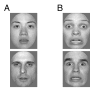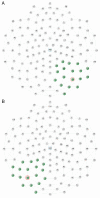The face-specific N170 component is modulated by emotional facial expression
- PMID: 17244356
- PMCID: PMC1794418
- DOI: 10.1186/1744-9081-3-7
The face-specific N170 component is modulated by emotional facial expression
Abstract
Background: According to the traditional two-stage model of face processing, the face-specific N170 event-related potential (ERP) is linked to structural encoding of face stimuli, whereas later ERP components are thought to reflect processing of facial affect. This view has recently been challenged by reports of N170 modulations by emotional facial expression. This study examines the time-course and topography of the influence of emotional expression on the N170 response to faces.
Methods: Dense-array ERPs were recorded in response to a set (n = 16) of fear and neutral faces. Stimuli were normalized on dimensions of shape, size and luminance contrast distribution. To minimize task effects related to facial or emotional processing, facial stimuli were irrelevant to a primary task of learning associative pairings between a subsequently presented visual character and a spoken word.
Results: N170 to faces showed a strong modulation by emotional facial expression. A split half analysis demonstrates that this effect was significant both early and late in the experiment and was therefore not associated with only the initial exposures of these stimuli, demonstrating a form of robustness against habituation. The effect of emotional modulation of the N170 to faces did not show significant interaction with the gender of the face stimulus, or hemisphere of recording sites. Subtracting the fear versus neutral topography provided a topography that itself was highly similar to the face N170.
Conclusion: The face N170 response can be influenced by emotional expressions contained within facial stimuli. The topography of this effect is consistent with the notion that fear stimuli exaggerates the N170 response itself. This finding stands in contrast to previous models suggesting that N170 processes linked to structural analysis of faces precede analysis of emotional expression, and instead may reflect early top-down modulation from neural systems involved in rapid emotional processing.
Figures




Similar articles
-
Face and emotional expression processing under continuous perceptual load tasks: An ERP study.Biol Psychol. 2021 Apr;161:108056. doi: 10.1016/j.biopsycho.2021.108056. Epub 2021 Feb 23. Biol Psychol. 2021. PMID: 33636248
-
Cortical deficits of emotional face processing in adults with ADHD: its relation to social cognition and executive function.Soc Neurosci. 2011;6(5-6):464-81. doi: 10.1080/17470919.2011.620769. Epub 2011 Oct 3. Soc Neurosci. 2011. PMID: 21961874
-
Augmenting serotonin neurotransmission with citalopram modulates emotional expression decoding but not structural encoding of moderate intensity sad facial emotional stimuli: an event-related potential (ERP) investigation.J Psychopharmacol. 2010 Aug;24(8):1153-64. doi: 10.1177/0269881108097878. Epub 2008 Oct 2. J Psychopharmacol. 2010. PMID: 18832432 Clinical Trial.
-
Unconscious Processing of Facial Expressions in Individuals with Internet Gaming Disorder.Front Psychol. 2017 Jun 23;8:1059. doi: 10.3389/fpsyg.2017.01059. eCollection 2017. Front Psychol. 2017. PMID: 28690578 Free PMC article.
-
Distributed and interactive brain mechanisms during emotion face perception: evidence from functional neuroimaging.Neuropsychologia. 2007 Jan 7;45(1):174-94. doi: 10.1016/j.neuropsychologia.2006.06.003. Epub 2006 Jul 18. Neuropsychologia. 2007. PMID: 16854439 Review.
Cited by
-
ERP evidence on the interaction between information structure and emotional salience of words.Cogn Affect Behav Neurosci. 2013 Jun;13(2):297-310. doi: 10.3758/s13415-012-0146-2. Cogn Affect Behav Neurosci. 2013. PMID: 23292996
-
Task-irrelevant fear enhances amygdala-FFG inhibition and decreases subsequent face processing.Soc Cogn Affect Neurosci. 2016 Sep;11(9):1440-8. doi: 10.1093/scan/nsw054. Epub 2016 Jun 5. Soc Cogn Affect Neurosci. 2016. PMID: 27272198 Free PMC article.
-
Association between childhood maltreatment and adult emotional dysregulation in a low-income, urban, African American sample: moderation by oxytocin receptor gene.Dev Psychopathol. 2011 May;23(2):439-52. doi: 10.1017/S0954579411000162. Dev Psychopathol. 2011. PMID: 23786688 Free PMC article.
-
The effects of emotion priming on visual search in socially anxious adults.Cogn Emot. 2017 Aug;31(5):1041-1054. doi: 10.1080/02699931.2016.1180281. Epub 2016 May 19. Cogn Emot. 2017. PMID: 27198991 Free PMC article.
-
Meaning above (and in) the head: Combinatorial visual morphology from comics and emoji.Mem Cognit. 2022 Oct;50(7):1381-1398. doi: 10.3758/s13421-022-01294-2. Epub 2022 Mar 2. Mem Cognit. 2022. PMID: 35235175 Free PMC article.
References
Grants and funding
LinkOut - more resources
Full Text Sources
Other Literature Sources

